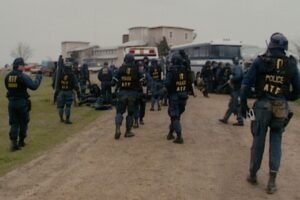‘Waco: American Apocalypse’ Review: A Calamity in Context
Article written by John Anderson for The Wall Street Journal

Punditry abounds regarding the polarization of the American political landscape right now, but what one might call the Big Bangs of government distrust—Ruby Ridge and Waco—are three decades old and continue to haunt a house divided. The federal government can be said to have misplayed its hand in both instances, to put it mildly. The events have been examined and re-examined, investigated and reinvestigated. But on the 30th anniversary of the Branch Davidian debacle, “Waco: American Apocalypse” attempts to put the Texas battle into a sensible context. And it’s a fascinating fool’s errand.
There’s a bit more narration than explanation in this three-part documentary series, though a deep dive into the personal enriches the storytelling. Heather Jones was 9 years old when she became the last child “freed” from the compound known as Mount Carmel Center during the 51-day standoff (she didn’t want to go). She breaks down several times in remembering her father, David, who was among the 76 Branch Davidians who died in the final conflagration on April 19, 1993 (a date commemorated two years later by Timothy McVeigh in Oklahoma City). Kathy Schroeder, a follower of the evidently delusional Branch Davidian “prophet” David Koresh, defends the sect’s beliefs and its leader’s dictates, including his sexual dominion over all women at the Mount Carmel compound. Chris Whitcomb, an FBI sniper who witnessed the entire siege, harbors such anger that one wonders if he should be handling a gun.
In the end, four federal agents and 82 Davidians would perish. What any student of Waco wants to know right away is who started it. Bill Buford and Jim Cavanaugh, former agents of the Bureau of Alcohol, Tobacco and Firearms, deny up and down that their people opened fire first, though, as the series mentions, the fired-on front door of the compound and the videotapes of the initial encounter disappeared long ago. Among the critical points made by “American Apocalypse” is that congressional appropriations hearings were coming up and the ATF, which had image problems, needed a big win. There’s no debate about illegal firearms being on the premises, which is why the bureau was serving a warrant. There’s also little argument that Koresh was a familiar figure around the Mount Carmel community (about 13 miles from Waco itself) and could have been arrested at almost any time. Even Mr. Buford remembers advising against the raid on that day, because the agency had lost the element of surprise. (Reporters had stopped a postman for directions to the compound and the raid they’d caught wind of; the postman was Koresh’s brother-in-law.)
Instead, the ATF arrived in a convoy of agents, who lost the initial firefight. As TV reporter John McLemore said at the time, Koresh might have thought he was the second coming of Jesus Christ, “but the Messiah’s well-armed this time.”
“Waco: American Apocalypse” is less forensic in its approach than, say, “Waco: The Rules of Engagement,” the 1997 documentary by William Gazecki, which had the advantage of immediacy, but also had to fight its way through a fog generated by congressional hearings, widespread obfuscation and a public perception skewed by claims of child abuse at the compound and the many disturbing truths about Koresh. For all its occasionally awkward sentimentality, director Tiller Russell’s new Netflix series benefits from a long-range perspective that supports its central thesis—that the unnecessary calamity of Waco was due to the inability, or outright refusal, of one U.S. government entity to listen to another.
Or even to itself: Then-FBI hostage negotiator Gary Noesner fairly sputters over the actions of his own bureau’s Hostage Rescue Team, which undercut negotiations at several points and took actions seemingly aimed at provoking further gunfire from inside the Mount Carmel Center.
“We could expect that something stupid was going to happen,” Dallas Morning News reporter Lee Hancock says about something specific, though her sentiment becomes redundant: As comfortably as Waco fits into deep-state conspiracy theories, “American Apocalypse” makes a better case for errors of incompetence, ego and machismo.
“Waco” suffers from a few missing details. Who ordered the assault despite Mr. Buford’s warning? Who misinformed Attorney General Janet Reno about child abuse at the compound? What happened to Heather Jones’s mother, who left the Branch Davidians “family” when Koresh began breaking up marriages and sleeping with the wives? At the same time, it features people very close to the subject being very open about what happened, even if, when all is said and done, they don’t understand it now any better than they did in 1993.





